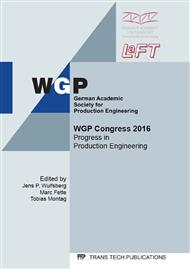p.83
p.91
p.99
p.107
p.115
p.123
p.133
p.141
p.149
Joining by Upset Bulging at Elevated Temperatures
Abstract:
Due to the limitations of other processes in joining different types of material, mechanical joining methods can be alternatively used. Joining by upset bulging can be employed for joining tubes with other structures such as sheets, plates, tubes or profiles as well as for joining different materials. In spite of successful industrial applications of this joining process, material damage is still a challenge. This damage affects the resistance of the created joint to service loads. Thus, in this paper, a local heating is studied, which aims at avoiding pre-damage or failure of the joint. A parametric FE model is developed to analyse the influence of local heating on the bulging process. It is found that the process window set by the bulge length suitable for joining is widened, but only to a minor extent. The marginal influence of local heating on the bulge geometry allows designing the process in the same way as room temperature processes. Metallographic investigations confirm the damage-free bulging of tubes by forming at elevated temperatures. Another important result is that tubes can be equipped with predefined bulge zones by local heating zones to 700 °C for 15 seconds for example. This enables bulging of tubes during joining by applying an axial load only, without using tools to define the location of the bulge or its length, thus enabling joining operations with limited access.
Info:
Periodical:
Pages:
115-122
Citation:
Online since:
August 2016
Keywords:
Price:
Сopyright:
© 2016 Trans Tech Publications Ltd. All Rights Reserved
Share:
Citation:


